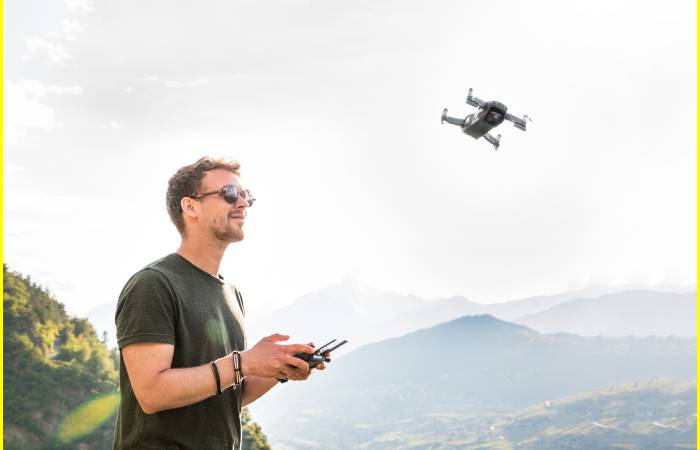What is Drone With a Camera?
Drone With Camera – Camera drones are uncrewed aerial vehicles that we can control remotely. They are device capable of maintain a controlled and sustained flight level. According to studies, initially, they were created for military purposes, especially for anti-aircraft shooting practice. However, they are currently used for search and rescue activities, surveillance, traffic monitoring, delivery services, or photography. The best camera drones capture panoramic images thanks to the 360º vision of their lens.
What Are The Advantages And Fields Of Application Of Camera Drones?
Camera drones take stunning bird’s-eye aerial shots. We can use these aircraft for filming and photography activities, disaster management, surveillance and monitoring, surveying, and mapping. Currently, drones are an already consolidated product. In this comparison of the best drones, you will discover the types of camera drones, the specifications of each model, and the opinions of users and experts.
Multi-rotor camera drones are made up of a central body and multiple rotors. Rotors are parts that propel the propellers of the drone to fly. The number of rotors varies and is classified as Tricopters (3 rotors), Quadcopters (4 rotors), Hexacopters (6 rotors), and Octocopters (8 rotors).
In expert opinion, quadcopters are the most popular multirotor drones on the market. They are typically used for visual inspections, photography and videography, thermal monitoring, and 3D imaging scans. Its structure provides better control of the aircraft during flight. They are capable of flying much closer to structures and buildings. Its battery gives it a flight autonomy of between 20 to 30 minutes. This model usually has outstanding value for money, but some options in the category are costly.
What Is The Method Of Operate Drone Camera?

All camera drones have their differences, and you will find a lot of variety in terms of performance and design. Some offer better range and are more durable, while others provide superior photo and video recording hardware
Basic Operating Procedures To Follow When Using Your New Camera Drone
Get To Know The Controls And Settings Of Your Drone
This may seem like a no-brainer, but ensuring you know the controls backward and forwards is essential. We mentioned earlier that quadcopter camera drones fly using two pairs of rotors that spin in different directions. This balance of forces lets the drone remain oriented and upright without the helicopter’s tail rotor. In addition, standard remote control setups are built with two joysticks that allow you to control the orientation and movements of the drone.
Check The Battery
When your flight plan takes you to potentially inaccessible areas on foot, it is essential to know your battery levels and keep your charge at a reasonable level. A low battery means dealing with the threat of giving up your drone if it crashes somewhere, making recovery challenging or outright impossible. Staying on top of battery power and carrying backup batteries are great ways to avoid hassles and potential costs in terms of money, time, or even personal safety.
Always Be Alert And Keep An Eye Arranged Your Drone At All Times
Most drones are sentient, so they must be aware of their position. If you lift it too hard in any direction at the wrong time, it could collide or crash into obstacles. Before performing complex maneuvers or accelerating too quickly, take note of your surroundings and any unexpected weather patterns. A remote GPS module will usually help your drone maintain its position when it’s not moving, but it can still be subject to wind or unexpected spin. These resources that you can occasionally be at risk of having a collision or an accident.
Drones And The Environment
A drone armed with a thermographic camera can give us, for example, a complete view of the state of a landfill: hot spots, wet areas, etc., or it can be used to fly over large areas of vegetation and thus facilitate maintenance tasks. In environmental matters, drones also add up.
Highways
In the case of the upkeep of viaducts near a highway, chartering a drone to bring out the analysis is much cheaper and safer than picking up specialized personnel or sending a helicopter, alternatives that are also time-consuming. Of course, it does not prevent subsequent action in the event of a badly behaved being detected, but it does relieve some work that previously required on-site personnel.
Airports
There are already air traffic control and security projects on airport runways. One example was the project at Southampton Airport, consisting of a predator-shaped drone, which reduced the number of birds on the runway by 74%, translating into a significant reduction in airport operating costs.
Conclusion
It’s also important to keep an eye out for anything that might interfere with your remote’s signal. Moving too far away or obstructing certain materials can cause potentially dangerous signal loss. You should always know the range of your drone and be aware of any potential sources of interference. Flight autonomy facilitates the search for people in dangerous situations. The drone industry’s objective is to increase these aircraft’s flight times as much as possible


